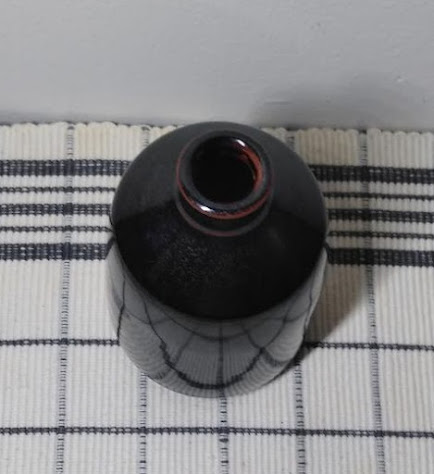157. Catherine Weir, small raku-fired pot with a matte copper glaze on the exterior, and a glazed interior, ca. 1995‑2000
Color of clay unknown. Interior glazed with a protective glaze; exterior coated with a matte copper glaze, with colors resulting from wood- and raku-firing. Weight: 156 g (5.5 oz). Rim diameter 5.7 cm (2-1/4 in); maximum diameter: 9.5 cm (3-3/4 in); base diameter: 3.6 cm (1-3/8 in). Height: 6.7 cm (2-5/8 in).
Weir practices and teaches ceramics in the Hamilton, Ontario, area. For more on her and other examples of her work, visit her website: www.catherineweir.ca. She specializes in raku ware.
This sits directly on the base, which was slightly hollowed out to form a small concave dent in the center. The artist signed the pot, using a brush to write her surname “Weir.” Above the base the walls of the pot extend outward at about a 45-degree angle for the distance of 1 cm (3/8 in); a definite break sensible to the fingers is apparent at this point. The walls then move outward at a steeper angle in more or less a straight line to just below the shoulder. The maximum width is at the shoulders, 5.2 cm (2 in) above the base. The shoulders are rounded. Above the shoulders, the wall moves in a straight line to the opening at the rim for a distance of 1.7 cm (5/8 in). The lip of the rim is rounded. The interior of the pot shows throwing marks. The exterior was smoothed off. The interior is smooth to the touch, the exterior is slightly rough from the wood-firing and the raku process.
The interior of this has a protective glaze, presumably to allow the pot to hold water. The mottled colors range from black through a grayish-blue to a dark scarlet. The exterior of this was coated with a matte copper glaze. The wood-firing and the raku process added other colors. A coppery sheen is visible over much of the pot. Other colors on the exterior are black, russets, browns, and blue. The artist’s signature appears to have been written in gold over the finished pot. The artist (pers. comm.) informed me that this was reduction fired.
This is much lighter than one would expect for a pot of this size. The shaping of the pot reflects a high degree of skill in throwing and trimming. This small object moves in many different directions, but each section is consistent and even. Through careful control of the glazing and the firing, Weir managed to achieve a wide range of coloring.
Purchased from Ver Sacrum Studio in Philadelphia, in November 2021.




































